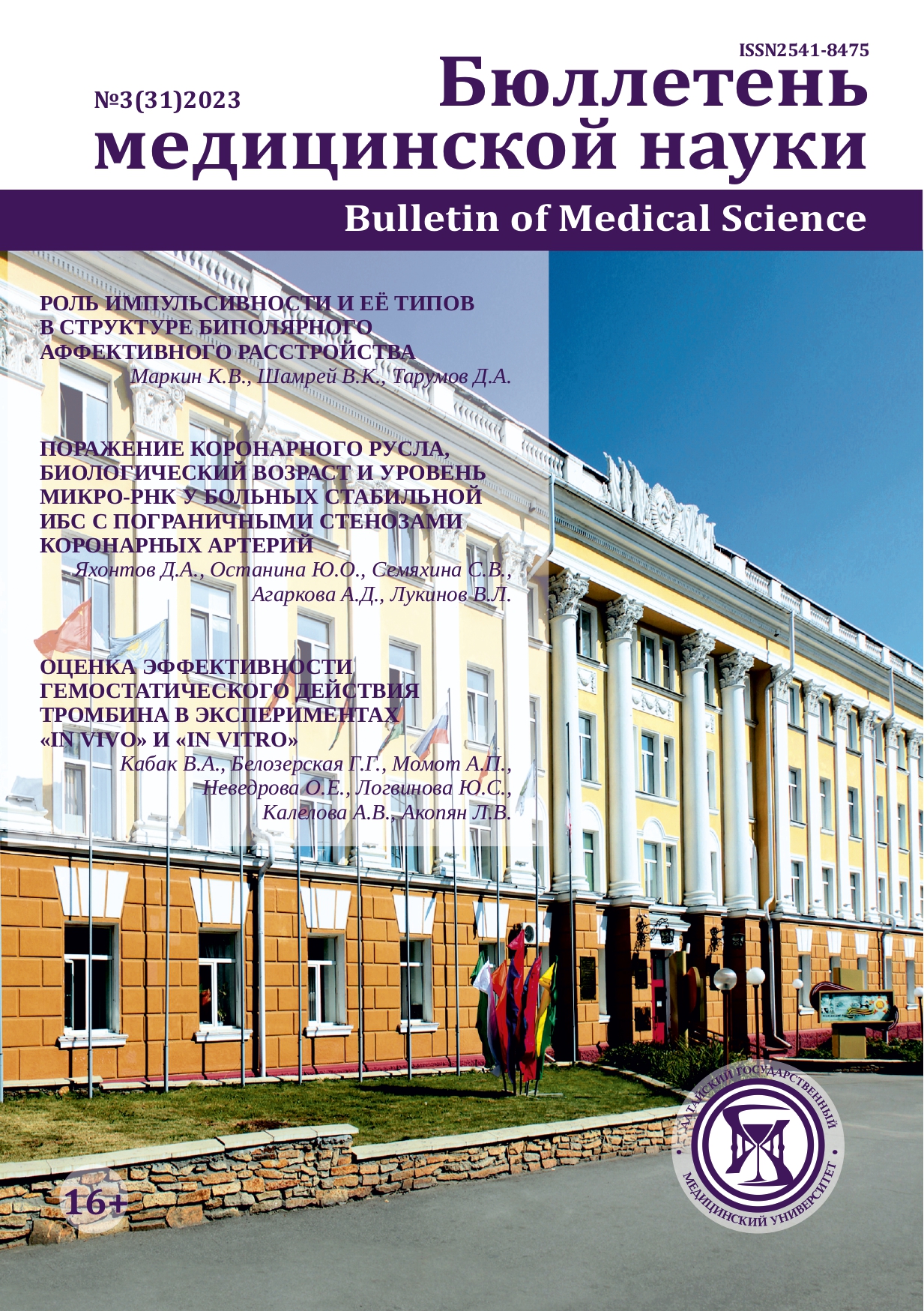RECURRENT ARTERIAL THROMBOSES ON THE BACKGROUND OF THROMBOPHILIA CAUSED BY HETEROZYGOUS F II MUTATION OF PROTHROMBIN IN A YOUNG PATIENT WITH REPEATED MYOCARDIAL INFARCTION (CLINICAL CASE)
UDC 616.127-005.8:616.13-005.6-005.7
DOI:
https://doi.org/10.31684/25418475-2023-3-104Keywords:
acute myocardial infarction, thrombophilia, thrombosis, ulcerative colitisAbstract
Introduction. Myocardial infarction is developing in young people, the cause of which can be not only atherosclerotic lesions of the coronary arteries, but also thrombophilia, leading to thrombosis. Clinical example. A 42-year-old woman was admitted with signs of acute recurrent ST elevation myocardial infarction with symptoms of cardiogenic shock. Prehospital thrombolytic therapy was performed. History of coronary artery stenting in 2017, nonspecific ulcerative colitis (NUC), mild chronic iron deficiency anemia. According to coronary angiography (CAG), performed using the femoral approach: AIS - thrombosis in the distal bed. The 2 lateral balloon angioplasty branch was performed. In admission analysis: troponin I more than 50,000 ng/l, hemoglobin 94 g/l; prothrombin time 15 sec; fibrinogen 3.8 g/l; APTT 41 sec. On the first day, acute thrombosis developed in the common femoral artery (АF), the superficial femoral artery on the right. Against the backdrop of triple antithrombotic therapy (aspirin 100 mg, clopidogrel 75 mg, heparin), there was a stool with blood streaks with a decrease in hemoglobin to 81 g/l. Hemotransfusion of the erythrocyte mass was carried out. MCT of the chest organs revealed bilateral pneumonia, hydrothorax. According to echocardiography, EF is 47%, systolic pressure in the right ventricle (RVS) is 53 mm Hg. In dynamics, hemoglobin increases to 129 g / l. Consulted by a hematologist, a heterozygous F2 mutation of prothrombin was detected. Long-term use of rivaroxaban is recommended. According to the lower extremity lower extremity lower extremity lower extremity lower extremity duplex of the arteries in dynamics, the state after post-catheter acute thrombosis post-catheter of the arteries of the femoral segment on the right. Occlusion of the anterior tibial artery. She was discharged with an improvement on day AMI on therapy with clopidogrel 75 mg for 12 months, rivaroxaban 15 mg. According to echocardiography, EF is 47%, systolic pressure in the right ventricle (RVS) is 53 mm Hg. In dynamics, hemoglobin increases to 129 g / l. Consulted by a hematologist, a heterozygous F2 mutation of prothrombin was detected. Long-term use of rivaroxaban is recommended. According to the lower extremity dynamics, lower extremity dynamics lower extremity dynamics lower extremity dynamics duplex of the arteries, the state after post-catheter acute thrombosis of the arteries of the femoral segment on the right. Occlusion of the anterior tibial artery. She was discharged with improvement on day 29 of AMI on therapy with clopidogrel 75 mg for 12 months, rivaroxaban 15 mg. According toechocardiography, EF is 47%, systolic pressure in the right ventricle (RVS) is 53 mm Hg. In dynamics, hemoglobin with an increase to 129 g / l. Consulted by a hematologist, a heterozygous F2 mutation of prothrombin was detected. Long-term use of rivaroxaban is recommended. According to the lower extremity dynamics lower extremity dynamics lower extremity dynamics duplex of the arteries - the state after post-catheter acute thrombosis of the arteries of the femoral segment on the right. Occlusion of the anterior tibial artery. She was discharged with improvement on day 29 of AMI on therapy with clopidogrel 75 mg for 12 months, rivaroxaban 15 mg. According to the duplex of the arteries of the lower extremities in dynamics - the state after post-catheter acute thrombosis of the arteries of the femoral segment on the right. Occlusion of the anterior tibial artery. She was discharged with improvement on the 29th day 29 of AMI on therapy with clopidogrel 75 mg for 12 months, rivaroxaban 15 mg. According to the duplex of the arteries of the lower extremities in dynamics - the state after post-catheter acute thrombosis of the arteries of the femoral segment on the right. Occlusion of the anterior tibial artery. She was discharged with improvement on the 29th day 29 of AMI on therapy with clopidogrel 75 mg for 12 months, rivaroxaban 15 mg. Discussion. The complexity of the patient lies in the fact that, along with recurrent arterial thrombosis, there is an autoimmune disease with damage to the gastrointestinal tract, leading to a decrease in hemoglobin that required blood transfusion, preventing the appointment of proper antithrombotic therapy. Conclusion. Thrombophilia caused by a heterozygous F-II mutation of prothrombin is the main cause of acute arterial thrombosis of various localizations. The possibility of its prevention is a timely genetic study to identify gene polymorphism and the appointment of anticoagulant therapy.
Downloads
References
Downloads
Published
How to Cite
Issue
Section
License
Copyright (c) 2023 Ольга Владимировна Демчук; Ирина Александровна Сукманова

This work is licensed under a Creative Commons Attribution 4.0 International License.












